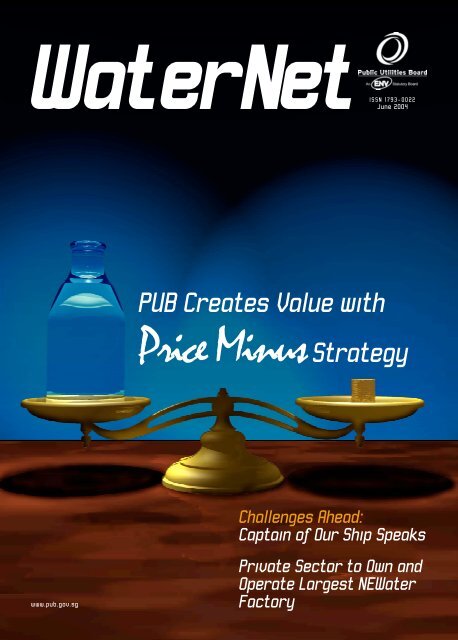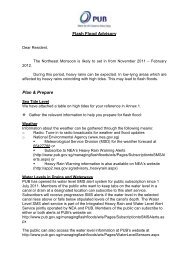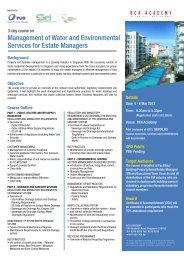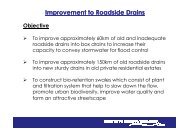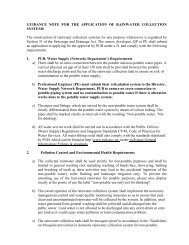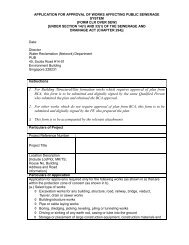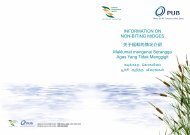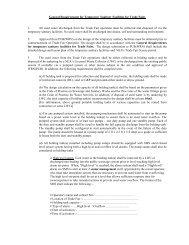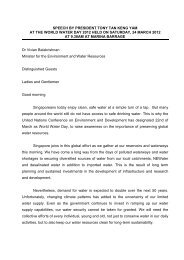PUB Creates Value with
PUB Creates Value with
PUB Creates Value with
Create successful ePaper yourself
Turn your PDF publications into a flip-book with our unique Google optimized e-Paper software.
WaterNet<br />
ISSN 1793-0022<br />
June 2004<br />
<strong>PUB</strong> <strong>Creates</strong> <strong>Value</strong> <strong>with</strong><br />
Price Minus Strategy<br />
www.pub.gov.sg<br />
Challenges Ahead:<br />
Captain of Our Ship Speaks<br />
Private Sector to Own and<br />
Operate Largest NEWater<br />
Factory
pg2<br />
WaterNet is a quarterly publication of the <strong>PUB</strong>,<br />
available in print and on the Internet. The name<br />
of the publication is inspired by our core business,<br />
water, and our desire to establish a strong network<br />
<strong>with</strong> our 3P (Public, Private and People sectors)<br />
partners and customers. We believe that such a<br />
strong network will be instrumental to the success<br />
of our business, much like the network of water<br />
supply, wastewater collection and drainage systems<br />
that remain central to our operations.<br />
As of April 2001, <strong>PUB</strong> is the statutory board in<br />
charge of the entire water loop, from collection,<br />
treatment and supply of water, to managing the<br />
wastewater collection and treatment systems,<br />
including NEWater, as well as the drainage systems.<br />
Ready and Swift<br />
in a Crisis<br />
<strong>PUB</strong>’s operations at the Nicoll<br />
Highway incident site<br />
Contents<br />
02 Ready and Swift in a Crisis<br />
<strong>PUB</strong>’s operations at the Nicoll<br />
Highway incident site<br />
03 Captain of Our Ship<br />
05 Drainage Initiatives<br />
to Reduce Flooding<br />
06 Price-Minus<br />
Towards <strong>Value</strong> Creation<br />
08 First Desalination Plant<br />
Launched in Singapore<br />
Private Sector to Design, Build,<br />
Own & Operate Largest<br />
NEWater Factory<br />
09 Towards 3P Community<br />
Ownership<br />
The <strong>PUB</strong>-IES Memorandum<br />
of Understanding<br />
10 ISO 9001, ISO 14001 and<br />
OHSAS 18001<br />
WRPs Have Them All!<br />
11 Sail Away<br />
The collapse of the Nicoll Highway<br />
on 20 April 2004 called for urgent<br />
mobilisation and despatching of <strong>PUB</strong><br />
officers to respond and provide<br />
support to Singapore Civil Defence<br />
Force at site. Throughout this<br />
operation, various teams from the<br />
<strong>PUB</strong> worked collectively, displaying<br />
decisiveness and swiftness to ensure<br />
quick remedy, at the same time<br />
ensuring that the water, drainage and<br />
sewerage systems in the vicinity of the<br />
incident site could continue to function.<br />
The Operations<br />
Upon receiving the SCDF’s call on the<br />
collapse, teams comprising officers<br />
from Water, Drainage and Sewerage<br />
departments, like well trained soldiers,<br />
made their way speedily to the incident<br />
site. The scene that greeted them was<br />
like a “war-zone”.<br />
When our officers saw the leak from<br />
a water pipeline, they knew they had<br />
to quickly turn off the control valve<br />
to stop the leak. But this was an<br />
operation that involved some risk, as<br />
the leaking watermain was located<br />
next to a damaged gas pipeline.<br />
Determination and courage quickly<br />
prevailed, as the team instantly crossed<br />
the leaking gas pipeline and successfully<br />
isolated the leaking watermain in a<br />
mere 15 minutes. Officers also took<br />
proactive action to isolate an 800mm<br />
watermain adjacent to Nicoll Highway<br />
as a precautionary measure. They also<br />
checked and confirmed that there<br />
were no leaks in the other watermains.<br />
Meanwhile, another team worked<br />
steadily on the drains in the vicinity<br />
which were damaged and had resulted<br />
in water flowing into the incident site.<br />
To mitigate this, our officers <strong>with</strong> the<br />
help of LTA constructed sandbag walls<br />
to block off the drain, which could<br />
cause upstream flooding if unattended<br />
to. Follow-up action was initiated<br />
rapidly to construct a temporary<br />
diversion drain to replace the damaged<br />
drain <strong>with</strong>in 48 hours.<br />
Additional officers were also activated<br />
to open manholes from Beach Road to<br />
North Bridge Road to check that the<br />
sewer lines are still intact and ensure<br />
that our public sewerage system is<br />
functioning smoothly.<br />
The <strong>PUB</strong> also established communication<br />
links <strong>with</strong> the management of various<br />
buildings in the affected area to garner<br />
valuable feedback, which proved to be<br />
helpful in making critical decisions. In<br />
addition, the <strong>PUB</strong> advised the Building<br />
Construction Authority and Golden Mile<br />
Complex managing agent on how to<br />
reduce the loading on the building <strong>with</strong>out<br />
affecting the water demand of customers.<br />
Throughout this operation, the <strong>PUB</strong><br />
had displayed swiftness, readiness<br />
and effectiveness in managing a crisis<br />
situation. This was only possible <strong>with</strong><br />
the support of a competent and<br />
dedicated workforce.
pg3<br />
Captain of Our Ship<br />
He’s Mr Khoo Teng Chye, Chief Executive (CE) of the <strong>PUB</strong>. Newly appointed in December 2003, Mr<br />
Khoo sat down <strong>with</strong> WaterNet to chat about his impressions of <strong>PUB</strong>, the challenges ahead, and the<br />
joys in his life.<br />
WaterNet<br />
Mr Khoo<br />
Congratulations on your new<br />
appointment as CE of the <strong>PUB</strong>. Do share<br />
<strong>with</strong> us how you feel at this point in time.<br />
I feel proud to be part of this team<br />
of dedicated professionals who are<br />
committed to fulfi lling the Board’s<br />
mission and have done Singapore proud<br />
over the years in meeting the diffi cult<br />
challenges of ensuring that we have<br />
adequate supply of water at an affordable<br />
cost. I know how tough the challenge is<br />
because as the head of URA previously,<br />
I know that we pushed the <strong>PUB</strong> to<br />
really stretch its limit to allow urban<br />
development in our water catchment<br />
areas; as we have limited land as an island<br />
nation. <strong>PUB</strong>’s continuing challenge is to<br />
try to collect and use and reuse every<br />
drop of water.<br />
CE sharing a moment <strong>with</strong> his family.<br />
WaterNet<br />
Mr Khoo<br />
What are the key challenges for <strong>PUB</strong>?<br />
Over the next few years, there will be major shifts in how we<br />
manage water resources and in the role of the <strong>PUB</strong>. For instance,<br />
NEWater will be produced on a large scale for both non-potable<br />
and indirect potable uses. The Deep Tunnel Sewerage System that<br />
we are developing now will impact the way used water is treated.<br />
Valuable land will be freed for development when we phase out<br />
the existing water reclamation plants. The <strong>PUB</strong> will also work more<br />
closely <strong>with</strong> private companies, for example in the production of<br />
NEWater and desalted water. We will take a 3P partnership and<br />
ownership approach in water resource management. A key success<br />
factor is human resource. We are strong in our technical capabilities<br />
and we will always require good engineers and water experts. But<br />
we also need to diversify the Board’s human capital <strong>with</strong> people <strong>with</strong><br />
a different set of skills, such as fi nancial, business, and legal skills, to<br />
enable us to work more effectively <strong>with</strong> the private sector.<br />
Singapore’s economy is expected to grow at a slower pace now than<br />
before. Public fi nancial resources will therefore be more scarce in the<br />
future. The <strong>PUB</strong> needs to exercise more effi ciency in the use of its<br />
resources. The challenge is to fi nd ways to balance our performance.<br />
We do well in our ability to supply enough water <strong>with</strong> the right<br />
quality. But we also need to do so at an affordable and competitive<br />
cost. So we need to carefully manage the capital that we use to<br />
deliver the results. We will use tools like Net Economic <strong>Value</strong> (NEV)<br />
to measure and manage our performance.
pg4<br />
These are interesting challenges ahead of us, but I am optimistic<br />
about our future because of our people. They are hardworking,<br />
professional and many are completely dedicated to the <strong>PUB</strong>’s mission.<br />
We have a wonderful mix of people - senior, experienced personnel<br />
and younger, energetic ones. We are also guided by our Chairman,<br />
who personifies the water story of Singapore and has created a<br />
strong and diverse Board <strong>with</strong> exceptional people who are also<br />
strong leaders in their fields. With the right ingredients, I’m sure we<br />
will meet the challenges ahead confidently.<br />
WaterNet<br />
Mr Khoo<br />
In the face of these challenges, what’s your advice to your staff?<br />
We are the masters of our own destiny. While we may have done<br />
well in the past, we must not rest on our laurels now. The world does<br />
not stop for us. Circumstances change. The public’s expectation of us<br />
keeps increasing, but resources to meet these challenges will diminish.<br />
So the challenge is how do we “Do More <strong>with</strong> less”. <strong>PUB</strong>’s strategy<br />
to do more <strong>with</strong> less is our “Price Minus Strategy”. This will be our<br />
thrust for the next three years.<br />
WaterNet<br />
Mr Khoo<br />
We would like to know more about you outside of work. Tell us, how do<br />
you spend your free time?<br />
My family is the anchor in my life. I like to spend time <strong>with</strong> my wife<br />
and two daughters, aged 21 and 19. Home is a comfortable cocoon I<br />
can always retreat to after a hard day at work.<br />
I always feel rejuvenated when I talk to my children. We enjoy friendly<br />
debates on various issues. Talking to my eldest daughter, who’s away<br />
in university in the United States, every Sunday evening on the phone<br />
gives me a tremendous uplift in my spirits.<br />
WaterNet<br />
Mr Khoo<br />
As CE, father, and husband, how do you manage the challenges of playing<br />
various roles in life?<br />
The key is to be aware of your own limitations. As CE, I’m like the<br />
captain of a ship, who steers ahead <strong>with</strong> information and advice from<br />
his crew. On my own, my decisions may not necessarily be the most<br />
appropriate. I seek different perspectives from my colleagues - the<br />
experts - before I make decisions. It’s important to recognise that I<br />
may err in my judgement on occasions and to react swiftly to make<br />
things right.<br />
At home, I’m more relaxed. I regard my wife as the CE at home, so I’ll<br />
take the backseat.<br />
WaterNet<br />
Mr Khoo<br />
WaterNet<br />
Mr Khoo<br />
What do you think is your greatest achievement to date?<br />
Singapore is what and where it is today because of the work of many<br />
people. I feel proud to know that I’ve played a small part in the<br />
nation’s development.<br />
What gives you the most joy in life?<br />
Being <strong>with</strong> my family gives me the greatest joy. My work in the<br />
<strong>PUB</strong> gives me great joy and I am game for the challenges ahead. It’s<br />
important to stay passionate about what you do.
pg5<br />
Drainage Initiatives to Reduce Flooding<br />
By Lo Siew Hong, Executive Engineer, Drainage Department<br />
A drainage offi cer gives a fl ood advisory to a shop owner.<br />
March 2004 will go down in<br />
Singapore’s meteorological history<br />
as the wettest March ever. But for<br />
drainage offi cers in the <strong>PUB</strong>, the<br />
month was memorable not only for<br />
the heavy downpours.<br />
The period stood out as a testing time<br />
for Drainage Department. The rains<br />
that lashed down islandwide put our<br />
drainage system to a serious challenge.<br />
On the days of ‘The Perfect Storm’, 8<br />
and 11 March, fl oods wrecked havoc<br />
in the low-lying areas as the higherthan-normal<br />
tide level coincided<br />
<strong>with</strong> intense rainfall. Homes, shops<br />
and underground car parks were<br />
inundated.<br />
To prepare the residents<br />
and shopowners in lowlying<br />
areas better, the <strong>PUB</strong><br />
will issue fl ood advisories<br />
to some 600 premises<br />
three days before a<br />
forecasted high tide so that<br />
precautions can be taken<br />
in advance should the high<br />
tide coincide <strong>with</strong> heavy<br />
rain.<br />
Going Forward<br />
The <strong>PUB</strong> will continue<br />
to improve the drainage system in<br />
Singapore to reduce fl ood-prone<br />
areas where it is cost-effective to do<br />
so. The <strong>PUB</strong> is now carrying out 23<br />
projects that will further reduce fl oodprone<br />
areas to 100 hectares by the<br />
end of 2007. These include drainage<br />
improvement works to Alexandra<br />
Canal, Joo Chiat Outlet Drain, and the<br />
International Road Outlet Drain.<br />
Alexandra Canal<br />
The $110-million project to improve<br />
the 4km Alexandra Canal will be<br />
implemented in two phases. When<br />
completed, it will reduce the risk of<br />
fl ooding in Jervois Road, Margaret<br />
Drive, Henderson Road, Lower Delta<br />
Road, and Tanglin Road.<br />
Joo Chiat Road Outlet Drain<br />
The improvement to this drain will<br />
alleviate fl ooding in the Changi Road/<br />
Langsat Road area when completed.<br />
Work on the 3km stretch to Changi<br />
Road is in progress, <strong>with</strong> the outfall at<br />
the sea and the drain to Marine Parade<br />
Road completed earlier.<br />
International Road Outlet Drain<br />
The improvement to this drain will<br />
alleviate fl ooding at Benoi Road,<br />
International Road and Soon Lee Road.<br />
The work on the 3.1km drain along<br />
International Road is expected to be<br />
completed in a year’s time.<br />
Marina Barrage<br />
Another comprehensive drainage<br />
scheme is the Marina Barrage. When<br />
completed, it will alleviate fl ooding in<br />
the low-lying areas in the city, such as<br />
Chinatown, Boat Quay, Jalan Besar,<br />
Rochor, Farrer Park, and Geylang.<br />
Even as we worked tirelessly <strong>with</strong> the<br />
affected parties to clear out the fl ood<br />
waters during the aftermath, it did<br />
not stop the public from expecting a<br />
well-engineered and compact city like<br />
Singapore to be free from fl oods.<br />
However, it is not realistic to expect<br />
Singapore to be completely fl ood-free<br />
as some areas are low-lying and barely<br />
above the high-tide level. These areas<br />
remain prone to fl ooding until their<br />
grounds are raised when they undergo<br />
redevelopment.<br />
We can also expect intense rainfall<br />
and extreme tides now and then,<br />
although they are assumed to be rare.<br />
The Government has spent $1.5 billion over the past 20 years to improve drains all over<br />
Singapore, greatly reducing fl ood-prone areas from 3200 hectares to 158 hectares today.<br />
One of the successful fl ood alleviation projects was the Bukit Timah/Dunearn Road diversion<br />
canal. Since its completion in the 1990s, fl ooding has not occurred in the Bukit Timah/<br />
Dunearn Road area.
pg6<br />
Price-Minus<br />
– Towards <strong>Value</strong> Creation<br />
Singapore is rising to the challenge of<br />
remaining competitive in the world by<br />
taking measures to keep rising costs<br />
in check. This applies to both public<br />
and private sectors as the government<br />
expects a tighter fiscal position in the<br />
coming years. This implies a possible<br />
shrinkage of the operating budget<br />
allocated to public agencies.<br />
The <strong>PUB</strong> will be of no exception.<br />
While continuing to provide “an<br />
adequate supply of water at affordable<br />
cost,” we will have to work doubly<br />
hard to ensure that all programmes<br />
will be financially sustainable in the<br />
long term. Our challenge would be to<br />
stretch and derive maximum returns<br />
from every dollar spent. A balance will<br />
have to be struck between services<br />
provided and cost (see “Our Balancing<br />
Act” on pg 7). In order to maintain a<br />
high level of service at a manageable<br />
cost, we need a new managing<br />
philosophy and organisational mindset<br />
that will inspire our employees across<br />
all levels to be cost-conscious and<br />
adopt a value creation decision-making<br />
process. And this, we call the Price-<br />
Minus philosophy.<br />
The Price-Minus Philosophy<br />
Price-Minus is not just about cutting<br />
costs. More importantly, it is about<br />
adopting a value creation approach<br />
in everything we do. If we merely<br />
concentrate on cutting cost, we will run<br />
the risk of cutting away both fat and<br />
muscle. We want to trim fat and build<br />
muscle instead, hence the concept of<br />
‘Doing More, With Less’. Ways must<br />
be identified to increase our value to<br />
our partners and customers and drive<br />
down costs at the same time. This way,<br />
we will become a leaner and nimbler<br />
organisation, one that is able to adapt<br />
to changes quickly.<br />
Responding to the Minister for the<br />
Environment’s challenge for the <strong>PUB</strong><br />
to become the first statutory board to<br />
successfully embrace the Price-Minus<br />
philosophy, Price-Minus Teams (PMTs)<br />
have been formed to look into areas that<br />
cut across the entire operations of <strong>PUB</strong>;<br />
both internally and externally. These<br />
PMTs will look into strategies outlined<br />
below under ‘Financial Sustainability’<br />
to reorganise and reposition <strong>PUB</strong> for<br />
future challenges. Some exciting projects<br />
undertaken by PMTs include working out<br />
a new structure for Singapore’s water<br />
industry, creating a performance-based<br />
compensation and reward framework,<br />
and ways to forge stronger partnerships<br />
<strong>with</strong> private and community partners.<br />
All these are done <strong>with</strong> ONE aim in<br />
mind - to help <strong>PUB</strong> achieve long-term<br />
sustainable growth while ensuring an<br />
adequate supply of water at affordable<br />
cost for Singapore.
pg7<br />
Our Balancing Act<br />
Striking a balance between the twin<br />
objectives of ‘Water Sustainability’<br />
and ‘Financial Sustainability’ is<br />
the essence of the Price-Minus<br />
philosophy. Under each objective, we<br />
have developed five strategies, which<br />
will be implemented in stages across<br />
the board over the next few years.<br />
Though ‘Water Sustainability’ will be<br />
our initial focus, we will gradually pay<br />
more attention towards achieving<br />
‘Financial Sustainability’ <strong>with</strong> the<br />
ultimate goal of reaching equilibrium<br />
and thereby more balanced and<br />
sustainable growth for the <strong>PUB</strong> and<br />
Singapore.<br />
Our strategies and their key thrusts<br />
<strong>Value</strong> PEOPLE<br />
- Align our people to the Price-<br />
Minus philosophy<br />
• A value-creation mindset, where<br />
decisions will be guided by a ‘value<br />
for money’ concept and a common<br />
language called NEV<br />
(see Box Story below)<br />
• A ‘reward for work and work for<br />
reward’ policy where our<br />
employees are rewarded for<br />
their outstanding performance and<br />
contributions<br />
• An organisational structural review<br />
to enable staff to have a better line<br />
of sight and staff accountability of<br />
their performance outcomes<br />
<strong>Value</strong> INNOVATION<br />
- Invest in technology and cultivate<br />
an innovative culture<br />
• A conducive environment for<br />
idea-creation and investment<br />
in modern technology to improve<br />
operational efficiency<br />
<strong>Value</strong> PARTNERSHIPS<br />
- Work <strong>with</strong> the private sector to<br />
improve supply efficiency and<br />
export capabilities<br />
• A strong network of partnerships<br />
<strong>with</strong> the private sector to<br />
improve supply efficiency,<br />
encourage innovation and boost<br />
export capabilities of our local<br />
technologies<br />
<strong>Value</strong> for MONEY<br />
- Using NEV to drive financial<br />
performance<br />
• A review of cost/capital structures<br />
and strategic assets to effectively<br />
deploy resources<br />
<strong>Value</strong> the COMMUNITY<br />
- Engage and involve the community<br />
• A higher level of interaction <strong>with</strong><br />
the community - from consultation<br />
to participation and ultimately,<br />
ownership of programmes<br />
Speaking “Net Economic <strong>Value</strong><br />
(NEV)”, our new language<br />
What is NEV?<br />
Net Economic <strong>Value</strong> (NEV) is true<br />
economic profit or wealth derived<br />
by subtracting the capital charge<br />
(capital investment multiplied by<br />
capital cost) from the net financial<br />
benefits of investment. This concept<br />
prevents managers from thinking<br />
that cost of capital is free when it<br />
is not.<br />
Why NEV for <strong>PUB</strong>?<br />
• Improve business decision-making<br />
at every level<br />
• Derive maximum value for our<br />
investments<br />
• Identify the areas where the costs<br />
can be reduced<br />
• Inculcate a mindset of value<br />
creation in employees at all levels
pg8<br />
First Desalination Plant<br />
Launched in Singapore<br />
By Sivaraman Arasu, Senior Manager, Water Department and<br />
Winston Chan Chee Kheong, Executive Engineer, Water Department<br />
A groundbreaking ceremony was held<br />
on 16 January 2004 to mark the start<br />
of the construction of Singapore’s fi rst<br />
large-scale seawater desalination plant<br />
at Tuas. Minister for the Environment,<br />
Mr Lim Swee Say, presided over the<br />
ceremony in the presence of more than<br />
250 guests.<br />
SingSpring Pte Ltd, a wholly-owned<br />
subsidiary of Hyfl ux Ltd, was awarded<br />
the Design-Build-Own-Operate<br />
(DBOO) contract for this desalination<br />
plant. It will supply 30 million gallons of<br />
desalinated water per day for the next<br />
20 years and this is scheduled to start by<br />
the second half of 2005.<br />
Mr Lim Swee Say, Minister for the Environment; Ms Olivia Lum, Group CEO & President, Hyfl ux Ltd;<br />
and Mr Tan Gee Paw, Chairman, the Public Utilities Board, are all smiles as they kick off the launch.<br />
Mr Lim, in his keynote address,<br />
highlighted two challenges for the <strong>PUB</strong>.<br />
The fi rst is to ensure that Singapore<br />
will always have enough safe and clean<br />
potable drinking water to meet the<br />
needs of our people and industries.<br />
The second is the challenge of keeping<br />
water supply at an affordable cost.<br />
Mr Lim said to ensure that our<br />
expanded water supply system is as<br />
cost-competitive as possible, the <strong>PUB</strong><br />
will adopt a “Best-Sourcing” approach.<br />
The <strong>PUB</strong> will tap on leading-edge<br />
technologies and expertise in the private<br />
sector and nurture the growth of the<br />
water industry. For NEWater, the <strong>PUB</strong><br />
will also invite the participation of private<br />
organisations by structuring the plant at<br />
Ulu Pandan as another project under the<br />
DBOO initiative.<br />
Private Sector to Design, Build, Own & Operate<br />
Largest NEWater Factory<br />
By Ong Hian Hai, Assistant Director, Water Reclamation Department<br />
The private sector can now play a<br />
part in ensuring the sustainability of<br />
Singapore’s water supply. The Ulu<br />
Pandan NEWater factory would be<br />
developed by the private sector based<br />
on the Design, Build, Operate, Own<br />
(DBOO) concept, as announced by<br />
Minister Lim Swee Say in January 2004.<br />
This fourth and largest NEWater<br />
factory is the <strong>PUB</strong>’s second DBOO<br />
project, the fi rst being the 30mgd<br />
desalination project.<br />
Tender for the Ulu Pandan NEWater<br />
Factory DBOO project was called<br />
on 30 April 2004. The factory will<br />
have an initial production capacity<br />
of 116,000m 3 /day (25mgd), <strong>with</strong><br />
provision for expansion to 140,000m 3 /<br />
day (30mgd). The <strong>PUB</strong> will purchase<br />
NEWater from the private sector over<br />
a 20-year term when the factory is<br />
completed in year 2006. This NEWater<br />
will be supplied to both industrial and<br />
commercial sectors in the western and<br />
central regions of Singapore.<br />
Over the last two years, the <strong>PUB</strong><br />
has established the sustainability and<br />
cost-effectiveness of NEWater after it<br />
has successfully constructed, managed<br />
and operated the plants at Bedok,<br />
Kranji and Seletar. The next step is<br />
to adopt a “Best Sourcing” approach<br />
to reap potential effi ciency gains and<br />
achieve cost-effectiveness through<br />
open competition. Over time, such a<br />
public-private sector partnership will<br />
help the private sector to develop<br />
niche water-reclamation technologies<br />
through mutual sharing of technological<br />
know-how and experience. These<br />
water-reclamation technologies can<br />
then be exported to other countries.<br />
Interested bidders can refer to the<br />
Government Electronic Business<br />
(GeBIZ) at www.gebiz.gov.sg for more<br />
details. More information on NEWater<br />
can also be found on the <strong>PUB</strong>’s website<br />
at www.pub.gov.sg
pg9<br />
Towards 3P Community Ownership<br />
The <strong>PUB</strong>-IES Memorandum of Understanding<br />
By Lee Bee Koon, Executive Engineer, Drainage Department<br />
Signatories and witnesses sign the MOU between the <strong>PUB</strong> and the IES.<br />
From left: Mr Tan Seng Chuan, Chairman of Environmental Engineering, Health<br />
& Safety Technical Committee; Dr Lock Kai Sang, President, IES; Mr Khoo Teng<br />
Chye, Chief Executive, <strong>PUB</strong>; and Mr Yap Kheng Guan, Director (Drainage), <strong>PUB</strong><br />
For many years, the <strong>PUB</strong> has relied on<br />
enforcement to control silty discharges<br />
from construction sites. But regulation<br />
alone is not effective; to achieve<br />
environmental sustainability, we have<br />
to take a 3P ownership approach.<br />
3P stands for the public sector, the<br />
private sector and the people. Besides<br />
the <strong>PUB</strong>, the industry and the general<br />
public also have to take ownership<br />
of the problem and value our<br />
environment and waterways.<br />
An excellent example of this approach<br />
was the joint <strong>PUB</strong>-IES Erosion and<br />
Sediment Control seminar held on<br />
8 April 2004. The Chief Executive of<br />
the <strong>PUB</strong>, Mr Khoo Teng Chye, said,<br />
“It is indeed encouraging to see<br />
different players from the engineering<br />
and construction industry come<br />
together to share knowledge,<br />
exchange views and work together<br />
to solve the problem of erosion and<br />
sediment control.”<br />
Held in conjunction <strong>with</strong> the seminar<br />
was the signing of a memorandum<br />
of understanding (MOU) on the<br />
collaboration of joint activities in<br />
environmental and water engineering<br />
Mr Khoo and Dr Lock ends the signing ceremony <strong>with</strong><br />
a warm handshake.<br />
between the <strong>PUB</strong> and the Institution<br />
of Engineers, Singapore (IES). The<br />
MOU was signed by Mr Khoo and<br />
Dr Lock Kai Sang, President of the<br />
IES. The signing of this MOU is<br />
the culmination of the efforts of<br />
Drainage Department and the IES’s<br />
Environmental Engineering, Health &<br />
Safety (EEHS) Technical Committee in<br />
their joint quest towards self-regulation<br />
in controlling silty discharge from<br />
construction sites.<br />
This MOU is therefore most timely<br />
for the <strong>PUB</strong> and the IES to work<br />
together to help engineering and<br />
construction industries improve the<br />
level of professional knowledge in<br />
environmental engineering, as well<br />
as to raise the profi le of Singapore<br />
and our environmental engineering<br />
professionals in the international arena<br />
through joint activities.<br />
More activities lined up by the IES<br />
and supported by the <strong>PUB</strong> are the<br />
formation of an Erosion Control<br />
Group associated <strong>with</strong> the IES’s<br />
EEHS Technical Committee and a<br />
professional course for the engineers<br />
starting from June this year.
pg10<br />
ISO 9001, ISO 14001 and OHSAS 18001 –<br />
WRPs Have Them All!<br />
By Ooi Kian Eng, Senior Manager, Water Reclamation Department<br />
All of our six Water Reclamation<br />
Plants (WRPs), Bedok, Kranji, Seletar,<br />
Kim Chuan, Jurong and Ulu Pandan<br />
WRPs, achieved the Integrated<br />
Quality, Environmental, Health<br />
and Safety or QEHS Management<br />
Systems in December 2003. This<br />
achievement reflects the WRPs’<br />
commitment to operations, service<br />
quality as well as staff welfare and<br />
preservation of the environment.<br />
The QEHS Management Systems<br />
comprise the ISO 9001:2001,<br />
ISO 14001:1996, and OHSAS 18001:<br />
1999 certifications.<br />
The WRPs first embarked on the<br />
journey to achieve the integrated<br />
QEHS certification in early 2003 <strong>with</strong><br />
the formation of different workgroups<br />
to review existing work documents and<br />
procedures. New procedures were<br />
developed to ensure conformance to<br />
the specifications of the respective<br />
management standard. Other than<br />
systems software, hardware was<br />
also provided at every WRP to meet<br />
environmental standards.<br />
To prepare for the implementation<br />
of the new management systems,<br />
the staff at the WRPs were given<br />
QEHS awareness training and regular<br />
updates on its progress. Workgroups<br />
attended specialised training in hazard<br />
identification, environmental impact<br />
assessment, and internal auditing.<br />
This training equipped staff better for<br />
their roles as drivers for the QEHS<br />
initiative and as internal auditors for<br />
the respective plants.<br />
The WRPs’ quest to attain the QEHS<br />
certification was not entirely smooth<br />
sailing. When SARS hit Singapore in<br />
March 2003, the WRPs were told to<br />
implement their business continuity<br />
plans like other organisations. Meetings<br />
and training sessions were cancelled.<br />
When the SARS crisis was finally<br />
over, work on the QEHS certification<br />
resumed immediately, and workgroups<br />
picked up the QEHS training on a more<br />
intensive pace to make up for lost time.<br />
The hard work of the WRPs finally<br />
paid off when they were all certified to<br />
have fully complied <strong>with</strong> the Integrated<br />
QEHS Management Systems by the<br />
Building Control Authority last year.<br />
This is yet another step the WRPs<br />
have taken to realise the vision of<br />
the <strong>PUB</strong> to be a living, learning, and<br />
caring organisation.
pg11<br />
Sail Away<br />
By Goh Chong Hoon, Senior Manager, Water Department<br />
The picturesque reservoirs, reservoir<br />
parks and the Central Water<br />
Catchment Nature Reserve are<br />
valuable water resources and also<br />
increasingly, recreational resources<br />
to the leisure-seeking public of landscarce<br />
Singapore. For many years,<br />
non-motorised water sports such as<br />
canoeing, kayaking, rowing as well as<br />
sports fi shing had been introduced<br />
at different reservoirs. Public safety<br />
and pollution control measures are<br />
put in place to ensure the safety of<br />
the participants and that the water<br />
quality is not affected in the reservoirs.<br />
As part of the Board’s initiative to<br />
promote community ownership of our<br />
waterbodies, we are taking a proactive<br />
step to introduce even more waterbased<br />
recreational activities in our<br />
waterbodies.<br />
We are already talking to our partners<br />
and interested parties to open up<br />
more of our reservoirs for waterbased<br />
activities. One of our partners,<br />
Singapore Canoeing Federation, has<br />
expressed delight on this initiative.<br />
Mr Henry Sim, Secretary-General<br />
of Singapore Canoeing Federation,<br />
said, “For the Singapore Canoeing<br />
Federation, we want to inculcate<br />
the right culture in our canoeing<br />
enthusiasts. They not only canoe, but<br />
also act as ambassadors for the <strong>PUB</strong><br />
when they enjoy the reservoirs and<br />
take ownership of the environment at<br />
the same time.”<br />
Bedok Reservoir will be next on the<br />
list for the introduction of waterbased<br />
activities. Mr Sim thinks that this<br />
reservoir will be a suitable venue for<br />
local and regional canoeing events as<br />
it offers spectators a good view of the<br />
whole reservoir.<br />
Pandan Reservoir: rowing and<br />
canoeing<br />
Lower Seletar Reservoir: sailing,<br />
canoeing, kayaking and sports fi shing at<br />
designated areas<br />
MacRitchie Reservoir: canoeing and<br />
sports fi shing at designated areas<br />
Upper Seletar, Lower Peirce and<br />
Kranji Reservoirs, and Jurong Lake:<br />
sports fi shing at designated areas<br />
New! Canoeing and mini dragonboating<br />
at Jurong Lake<br />
Coming soon! Activities at Bedok<br />
Reservoir
For a totally<br />
different experience,<br />
explore the NEWater Visitor Centre and witness fi rst-hand how<br />
this new and important source of water for Singaporeans is being<br />
processed using advanced membrane and ultraviolet technologies.<br />
Be edutained by multimedia entertainment presentations and<br />
computer interactives on the interesting facts of water sources in<br />
Singapore and around the world and other water-related issues.<br />
Don’t forget to check out the NEWater Factory <strong>with</strong> a daily<br />
production capacity of 32,000m 3 and of course, end off this exciting<br />
tour <strong>with</strong> a taste of NEWater!<br />
<br />
For tour bookings, please visit www.pub.gov.sg/newater or contact us at 65467874


